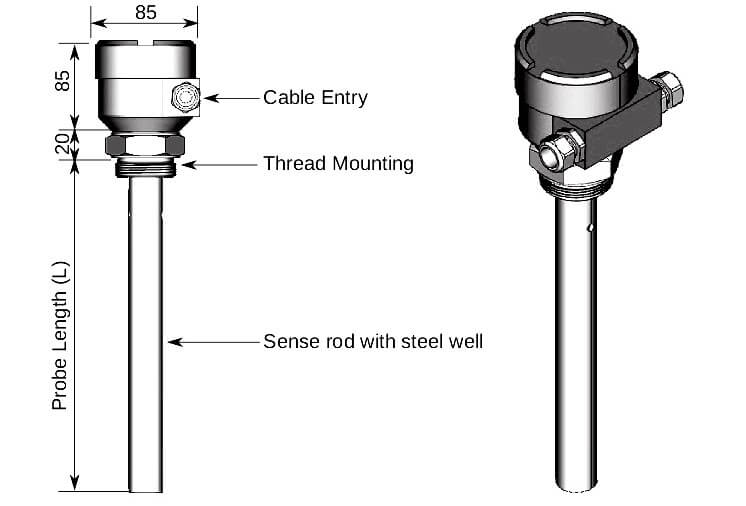What is capacitive level sensor?
Capacitive level sensors are operated by two electrodes forming a capacitor, often in the form of two parallel metal plates with insulating material separating them. In the most basic sense, capacitors store electrostatic energy in an electric field.
It is possible to detect the amount of liquid inside a container by using capacitive principles, which are explained in more detail below.
In response to the movement of a liquid inside a container, the dielectric effect of the liquid alters the effective capacitance of a sensing capacitor, which is detected by electronic circuitry connected to the sensor.
- One plate of the sensor capacitor is a probe placed inside a receptacle, and the other plate of the sensor capacitor is a grounded conductive part of the receptacle. The sensor capacitor is comprised of two plates. The liquid contained inside the receptacle serves as a dielectric between the two plates of the device.
- Essentially, a capacitor is made up of two electrodes that are electrically isolated from one another. The electrodes themselves must be conductive, and they are usually composed of metal to function properly. They may take on any form, but two parallel plates are the most easily seen of the options.
When a voltage or “potential” is supplied to a capacitor’s electrodes, the capacitor can store energy in an electric field created between the electrodes. The capacitance property is a relationship between the quantity of energy stored in a field and the voltage or potential.
By sandwiching a non-conductive substance between the electrodes, the capacitor’s capacity to store energy improves, and as a result, the capacitance rises in value. The substance that exists between the electrodes is referred to as the dielectric material.
The quantity of charge held by dielectric materials is the most important characteristic of dielectric materials.To assess the level of a dielectric liquid placed between the electrodes of a capacitor, the capacitance must be changed proportionally to the amount of liquid injected.
When the voltage or potential of the electrodes is changed, the electric energy flowing into and out of the electrodes is measured to determine how much variation there is in the capacitance.
The connection of the electrodes to an alternating current measuring circuit results in creating this flow of energy. The higher the amount of energy that flows between the electrodes, the greater the capacitance, which means more dielectric between them.
It is necessary to take reference measurements at both the empty and full tank levels to calibrate the level sensor. In most cases, the dielectric constant value of the liquid being measured is needed to allow calibration of the sensor at its “full” level to be possible.
Once the empty and full outputs have been configured, liquid level detection is just a matter of correlating the sensor output to these values. It is also possible to construct capacitor plates in the form of a concentric tube and rod, which has the benefit of decreased interference and increased mechanical rigidity and durability, as was done in the Gill liquid level sensors.
Conclusion:
All signal processing is handled on-board by the completely integrated electronics, which allows for greater efficiency. The management of dielectric fluctuation induced by temperature change is accomplished via offset values recorded inside the sensor memory, usually present during the factory calibration process at pcd-flowmeter.



Recent Comments